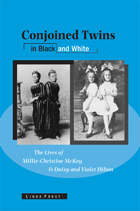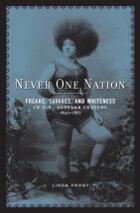2 books by Frost, Linda

Conjoined Twins in Black and White
The Lives of Millie-Christine McKoy and Daisy and Violet Hilton
Edited by Linda Frost
University of Wisconsin Press, 2009
Conjoined twins have long been a subject of fantasy, fascination, and freak shows. In this first collection of its kind, Millie-Christine McKoy, African American twins born in 1851, and Daisy and Violet Hilton, English twins born in 1908, speak for themselves through memoirs that help us understand what it is like to live physically joined to someone else.
Conjoined Twins in Black and White provides contemporary readers with the twins’ autobiographies, the first two “show histories” to be republished since their original appearance, a previously unpublished novella, and a nineteenth-century medical examination, each of which attempts to define these women and reveal the issues of race, gender, and the body prompted by the twins themselves. The McKoys, born slaves, were kidnapped and taken to Britain, where they worked as entertainers until they were reunited with their mother in an emotional chance encounter. The Hiltons, cast away by their horrified mother at birth, worked the carnival circuit as vaudeville performers until the WWII economy forced them to the burlesque stage. The hardships, along with the triumphs, experienced by these very different sister sets lend insight into our fascination with conjoined twins.
Conjoined Twins in Black and White provides contemporary readers with the twins’ autobiographies, the first two “show histories” to be republished since their original appearance, a previously unpublished novella, and a nineteenth-century medical examination, each of which attempts to define these women and reveal the issues of race, gender, and the body prompted by the twins themselves. The McKoys, born slaves, were kidnapped and taken to Britain, where they worked as entertainers until they were reunited with their mother in an emotional chance encounter. The Hiltons, cast away by their horrified mother at birth, worked the carnival circuit as vaudeville performers until the WWII economy forced them to the burlesque stage. The hardships, along with the triumphs, experienced by these very different sister sets lend insight into our fascination with conjoined twins.
[more]

Never One Nation
Freaks, Savages, and Whiteness in U.S. Popular Culture, 1850-1877
Linda Frost
University of Minnesota Press, 2005
In Never One Nation, Linda Frost argues that during the eventful decades surrounding the Civil War, American identity was constructed not only nationally but also locally. Depictions of race, class, and sexuality seen in P. T. Barnum's museums, in the image of the Circassian Beauty, and in popular periodicals like Harper's Weekly, the Southern Illustrated News, and the San Francisco Golden Era further illustrated who was - and who was not - an American. Local coverage of Native Americans and Chinese in the West, African Americans and recent Irish immigrants in New York, and slaves and Yankees in the South played a major role in conflating Americanness with whiteness. These ideas were shaped by reactions to events such as the 1863 Draft Riots and the Dakota uprising in Minnesota in 1862, and laid bare through the demonization of Northern whites in Confederate newspapers and anxieties expressed in California newspapers about the possibility of Chinese immigrants gaining U.S. citizenship. Through close readings of specific articles published in regional periodicals, mostly unexamined by literary scholars, Frost shows how Americanness came to be defined in the mid-nineteenth century by the mainstream popular culture. The era's many social upheavals - Emancipation, Reconstruction, the start of the Indian wars in the West, immigration, and the completion of the transcontinental railroad - sharpened the desire of Americans to feel part of a national community, even as they made this search for an American identity extremely contentious and necessarily fragmented. Never One Nation provocatively reframes the discourse on racial formation and reveals how local cultures and prejudices can recast the identity of a nation.
[more]
READERS
Browse our collection.
PUBLISHERS
See BiblioVault's publisher services.
STUDENT SERVICES
Files for college accessibility offices.
UChicago Accessibility Resources
home | accessibility | search | about | contact us
BiblioVault ® 2001 - 2024
The University of Chicago Press









